

List of popular music genres. This is a list of the commercially relevant genres in modern popular music.
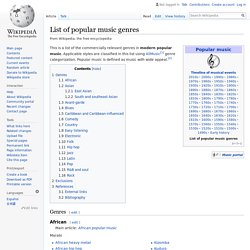
Applicable styles are classified in this list using AllMusic[1] genre categorization. Popular music is defined as music with wide appeal.[2] Genres[edit] African[edit] Marabi Asian[edit] East Asian[edit] South and southeast Asian[edit] Avant-garde[edit] Music genre. A music genre is a conventional category that identifies pieces of music as belonging to a shared tradition or set of conventions.[1] It is to be distinguished from musical form and musical style, although in practice these terms are sometimes used interchangeably.[2][not in citation given] Among the criteria often used to classify musical genres are: the trichotomy of art, popular, and traditional; time period; regional and national origins; technique and instrumentation; fusional origins; and social function.
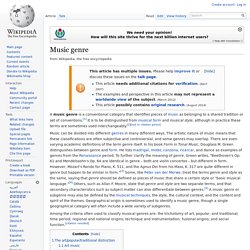
[citation needed] The art/popular/traditional distinction[edit] Musicologists have sometimes classified music according to a trichotomic distinction such as Philip Tagg's "axiomatic triangle consisting of 'folk', 'art' and 'popular' musics".[6] He explains that each of these three is distinguishable from the others according to certain criteria.[6] Outline of music. The following outline is provided as an overview of and topical guide to music:
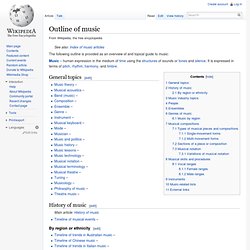
Aspect of music. Sonata. Sonata (/səˈnɑːtə/; Italian: [soˈnaːta], pl. sonate; from Latin and Italian: sonare, "to sound"), in music, literally means a piece played as opposed to a cantata (Latin and Italian cantare, "to sing"), a piece sung.
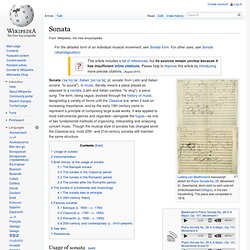
The term, being vague, evolved through the history of music, designating a variety of forms until the Classical era, when it took on increasing importance, and by the early 19th century came to represent a principle of composing large scale works. It was applied to most instrumental genres and regarded—alongside the fugue—as one of two fundamental methods of organizing, interpreting and analyzing concert music. Though the musical style of sonatas has changed since the Classical era, most 20th- and 21st-century sonatas still maintain the same structure. Usage of sonata[edit] The term sonatina, literally "small sonata", is often used for a short or technically easy sonata.
Mute (music) A mute is a device fitted to a musical instrument to alter the sound produced: by affecting the timbre, reducing the volume, or most commonly both.

The use of a mute is usually indicated in musical notation by the direction con sordino (often abbreviated con sord, sord, sordino). (Sordina, with plural sordine, is the strictly correct Italian term for mute as used on string instruments; but the forms con sordino, senza sordino, sordino via, etc., are much more commonly used as terms in music than the forms con sordina, senza sordine, etc.) The mute should be removed with the senza sordino (or senza sord, senza sordina, etc.) direction.
When written in English the directions, "mute" and "open" (for brass instruments) or "unmute" (for stringed instruments) are used. The equivalent German terms for "with mute" ("mute on") are mit Dämpfer (Dämpfer auf), and for "without mute" ("mute off") are ohne Dämpfer (Dämpfer ab/weg). In French music, the word for the mute is sourdine. Mute-on sign Mute-off. Tasto solo.
Vibrato. In singing it occurs spontaneously through a nervous tremor in diaphragm or larynx.
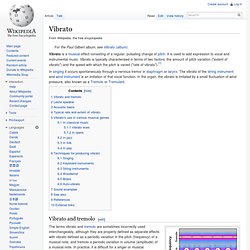
The vibrato of the string instrument and wind instrument is an imitation of that vocal function. In the organ, the vibrato is imitated by a small fluctuation of wind pressure, also known as a Tremolo or Tremulant. Vibrato and tremolo[edit] Spectrogram illustrating the difference between tremolo and vibrato. The terms vibrato and tremolo are sometimes incorrectly used interchangeably, although they are properly defined as separate effects with vibrato defined as a periodic variation in the pitch (frequency) of a musical note, and tremolo a periodic variation in volume (amplitude) of a musical note. Leslie speaker[edit] A Leslie speaker (best known through its historical and popular association with the Hammond organ) creates vibrato as a byproduct of tremolo production. Acoustic basis[edit] The use of vibrato is intended to add warmth to a note.
Glossary of musical terminology. This is a list of musical terms that are likely to be encountered in printed scores, music reviews, and program notes.
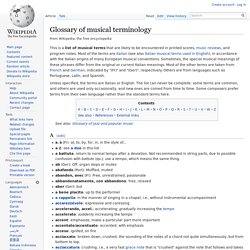
Most of the terms are Italian (see also Italian musical terms used in English), in accordance with the Italian origins of many European musical conventions. Sometimes, the special musical meanings of these phrases differ from the original or current Italian meanings. Most of the other terms are taken from French and German, indicated by "(Fr)" and "(Ger)", respectively. Others are from languages such as Portuguese, Latin, and Spanish.
Unless specified, the terms are Italian or English.